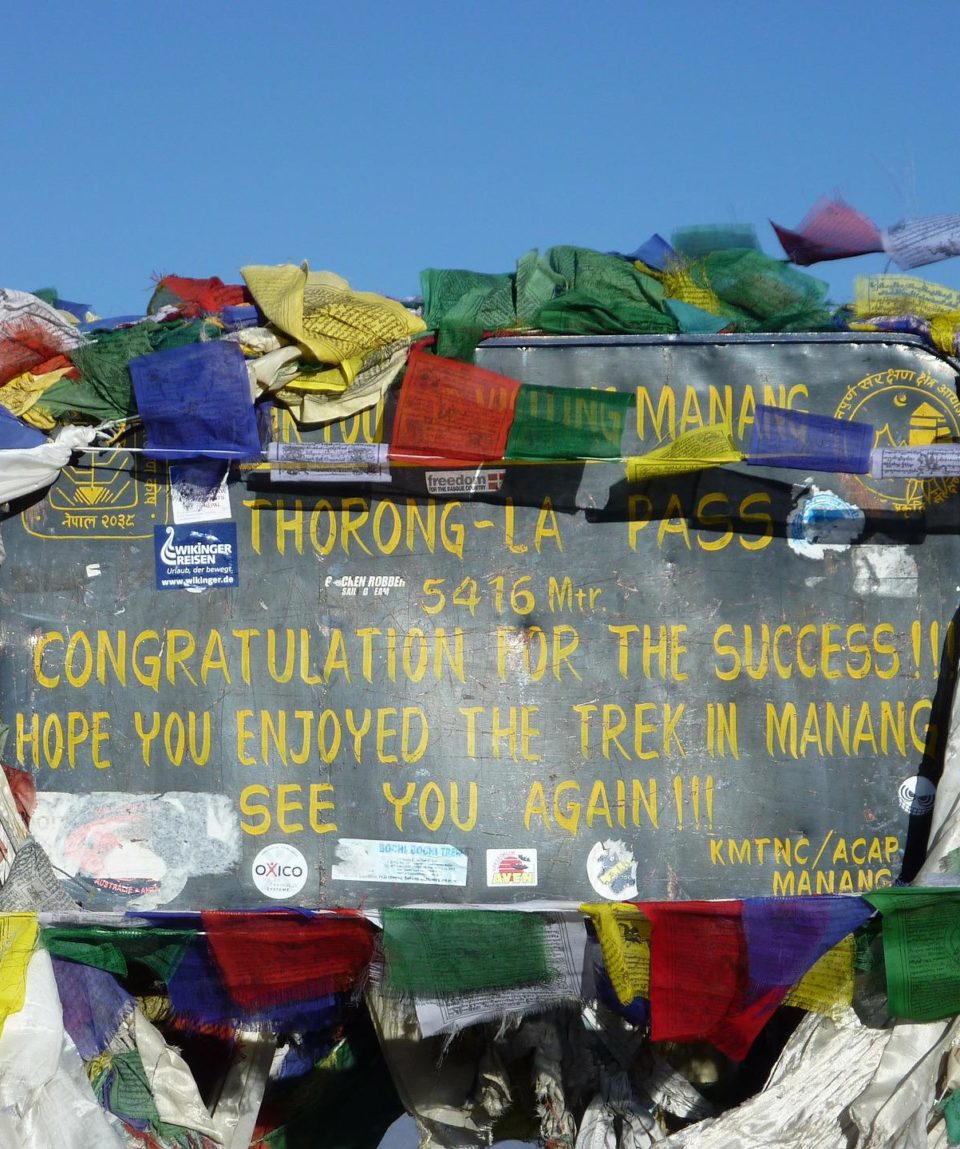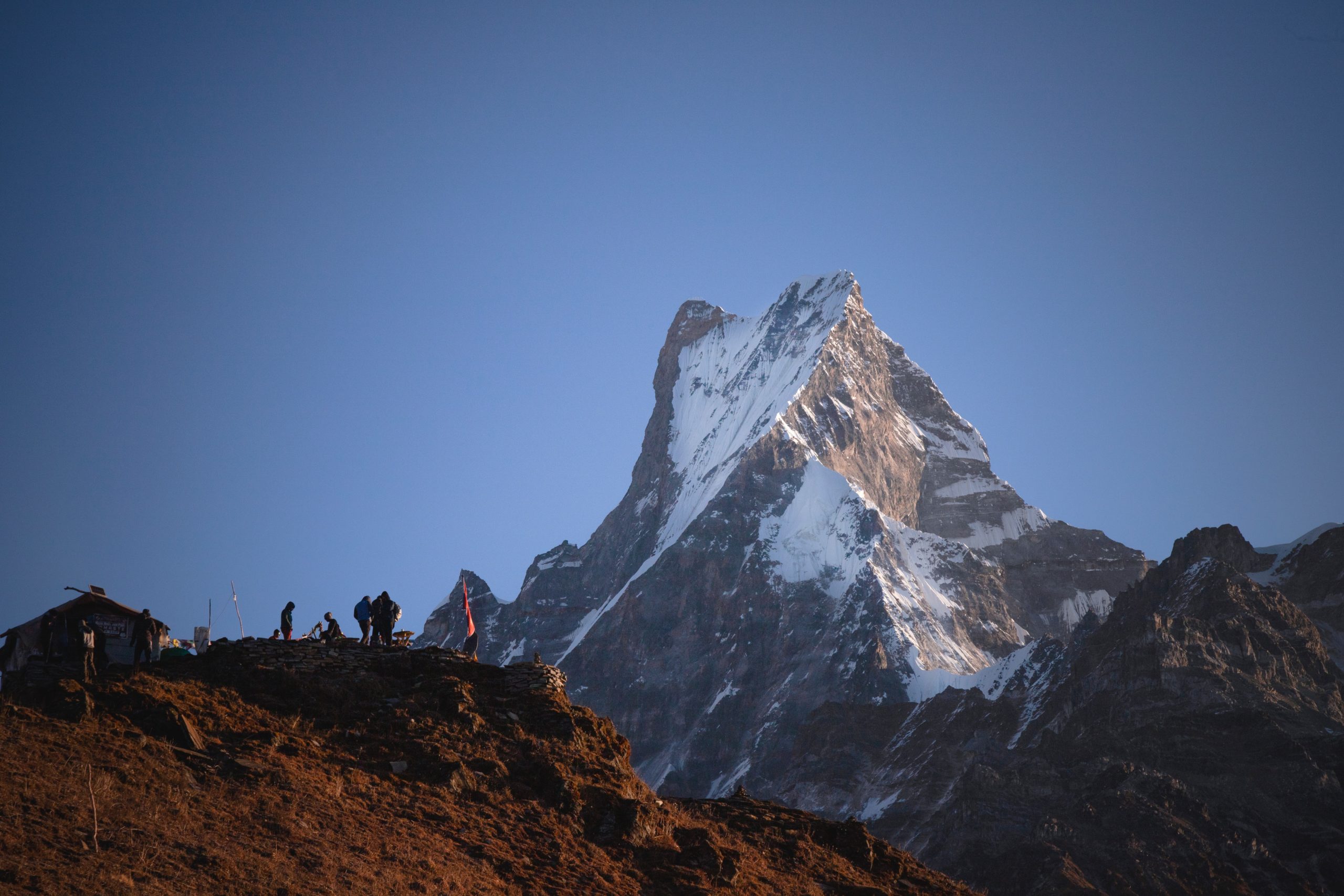
Annapurna Circuit Trekking
fromThe Annapurna Circuit trek navigates the Annapurna range, leading you to the Thorong La Pass (5,416m/17,769ft). This walk will excite you while also gratifying your eyes with mountains like Mt. Annapurna I rises to 8,091m (26,545ft) to the east and Mt. Dhaulagiri hovering at 8,167m (26,795ft) to the west, passing via the world’s deepest Kali Gandaki gorge.
Being one of the classic treks, and the third most popular trek in Nepal, the Annapurna circuit trek will take you to places like Manang, Jomsom, and the Muktinath regions that allow us to get acquainted with the diverse Nepalese landscape and culture.
Often regarded as a wilderness of mountains, this trek will allow you to witness a lot of high mountains including one peak over 8000 meters, thirteen peaks over 7000 meters, and sixteen more over 6000 meters.
The total distance of the trek ranges between 160 and 230 kilometers (100-145 miles), depending on the hike choices you choose. Because some of the roads of the Annapurna Circuit Trek are tarred, some hikers prefer to employ motorized transport to complete the trek. Aside from logistics, it provides a relaxing rest after a hard day of hiking.
The Annapurna Circuit Trek is mostly always done in the anti-clockwise orientation. As a result, the altitude increase is reduced, and people are less susceptible to altitude sickness. It’s a circular journey that takes you up one valley and over the Thorung La high pass (5412m), the route’s highest point, before descending another valley.
The walk is social and enjoyable, not too strenuous, and nights are spent in luxurious lodges with fresh and high-quality meals. Furthermore, you do not need to be an expert hiker to participate in this trip, but by the conclusion, you will be mountain fit, tanned, and full of optimism.
It’s difficult at times, but the route allows for excellent acclimatization prior to climbing the pass, and you’ll be in the safe and capable hands of our guide team.
Although you don’t need to be an expert hiker, you should proceed with caution because this walk is quite demanding. The climb from Thorong Phedi to Thorong La pass (5,416m) will be the most difficult because it is a steep 45-minute climb at this height. As a result, you’ll need to be physically fit because you’ll be walking significant distances every day for two weeks.
If you are confused about the permissions required for this trek, luckily, you will only need these two permits: Trekkers’ Information Management System (TIMS) and Annapurna Conservation Area Project (ACAP). Both of them can be arranged quite easily, either in Kathmandu or Pokhara.
This trek can be done in all seasons. However, the months from March to May (spring) and from October or November (autumn) are the best months for trekking the Annapurna Circuit.
The Annapurna Circuit Trek is best done in the spring. It’s the finest time to see rhododendrons in blossom and see the most gorgeous birds. On the trials, you should expect a lot of activity.
Similarly, due to the small amount of rain that the Annapurna region receives in the autumn season, everything has come back to life and is colorful. Teahouses fill up quickly, so the circuit is often very busy this time of year.
When it comes to lodging, you’ll be staying in teahouses in settlements along the way for the duration of the walk. These are pretty modest, featuring two wooden bench beds with mattresses and shared toilet facilities in each room.
Showers aren’t often accessible at teahouses, and the communal spaces are usually the only ones that are heated. These teahouses will charge you not just for the food you eat, but also for extra services like phone chargers, hot baths, and internet access.
The teahouse menus have improved dramatically in recent years, and you may now choose from a menu of perhaps 40 or 50 dishes, ranging from the basic DAAL BHAAT (Rice and lentils) to Yak steak with blue cheese sauce.
You may eat real Nepalese cuisine as well as international cuisines such as Tibetan, Continental, Italian, and Indian. Breakfast and dinner will be served from the teahouse menu where you will be staying the night, and lunch will be served on the way to your next destination.
All meals will be supplied on the trek, including breakfast, lunch, and dinner, however, just breakfast will be accessible in Kathmandu and Pokhara.
-
Reviews 0 Reviews0/5
-
Vacation Style Holiday Type
-
Activity Level Challenging
-
Group Size Small Group
The walk is social and enjoyable, not too strenuous, and nights are spent in basic teahouses with fresh and high-quality meals. Furthermore, you do not need to be an expert hiker to participate in this trip, but by the conclusion, you will be mountain fit, tanned, and full of optimism.
It’s difficult at times, but the route allows for excellent acclimatization prior to climbing the pass, and you’ll be in the safe and capable hands of our guide team.
Although you don’t need to be an expert hiker, you should proceed with caution because this walk is quite demanding. The climb from Thorong Phedi to Thorong La pass (5,416m) will be the most difficult because it is a steep 45-minute climb at this height. As a result, you’ll need to be physically fit because you’ll be walking significant distances every day for two weeks.
This trek can be done in all seasons. However, the months from March to May (spring) and from October or November (autumn) are the best months for trekking the Annapurna Circuit.
The Annapurna Circuit Trek is best done in the spring. It’s the finest time to see rhododendrons in blossom and see the most gorgeous birds. On the trials, you should expect a lot of activity.
Similarly, due to the small amount of rain that the Annapurna region receives in the autumn season, everything has come back to life and is colorful. Teahouses fill up quickly, so the circuit is often very busy this time of year.
Trekking Highlights:
- Walking through yak pastures
- Witnessing the spectacular views of Mt. Annapurna, Thorung Peak, Nilgiri, Chulu West, and Chulu East, Tukuche Peak, Dhaulagiri, Lamjung Himal, Annapurna II, and Annapurna IV.
- Beautiful lakes, glaciers, deep gorges, and waterfalls – Marsyangdi Lake, for example.
- Visiting the Muktinath temple, known for its 108 stone faucets and eternal flame
- Visiting and spending some time in the Manang district
- Visiting the Barge Monastery, the largest monastery in the Manang district
- Crossing Thorong La Pass at 5,416 meters
Why trek with us?
Quality:
We’re confident that the trip highlights have piqued your interest in doing the Annapurna Circuit Trek, and with us, we can make it even more glamorous. For us, quality entails not only luxury but also a sense of social togetherness. This connection is guaranteed by us. We plan our expedition such that you not only walk through the trail but also make memories with us and the locals. We’ll mingle with the people, take photos, share food, and make ourselves at home.
Giving back to the community:
We are a product of the Nepalese community, and as a part of it, with every journey we explore, we design some kind of activities that ensures the locals will be fully benefited. For our Annapurna Base Camp Trek, we can either donate books and stationery products at school in the rural settlements at Dovan, Chomrong, Tadapani, or Ghandruk(we can do this on any day from Day 5 to Day 7 of our trek). Similarly, we can also donate medical supplies to the camps (from Day 8 to 10). Likewise, we can donate clothes and other items to the Tibetan refugee camp while buying their local arts and crafts (on Day 12, after reaching Pokhara, or Day 17 before traveling back to Kathmandu). This will also allow you to connect to people well and help us evolve more.
- Pick up and transfer to the booked accommodation by Elite Explorer representative from Tribhuwan International Airport Kathmandu. (please look for your full name card outside the arrival hall, +977 985 115 5251 arrival assistance WhatsApp call or message)
- Twin sharing or double bed accommodation with buffet breakfast in Kathmandu and Pokhara.
- Guided, know your surrounding tour in Kathmandu.
- Private vehicle for ground transport in Kathmandu.
- Private jeep drives from Kathmandu to Besisahar.
- Guided trek by our expert and experienced English-speaking trekking guide. (language guide can be arranged based on your preference.)
- A porter to help carry our trekking bags (trekking bags must not exceed 20 kg, 2 pax combined )
- Locally available breakfast, lunch, and dinner including tea or coffee.
- Basic Mountain Lodges (famously known as tea houses) for accommodation.
- Guide Porter salary remunerations and insurance
- Trekkers Information Management System (TIMS) card
- Necessary documentation and Annapurna trekking permit.
- First aid kit including oxygen meter
- Ghasa Pokhara drive by locally available jeep.
- Pokhara Kathmandu thirty minutes domestic flight.
- Government tax
- Airport transfer upon completion of the program
- Client personal expenses and bar bill including soft drinks
- Natural Calamities beyond our control and expenses incurred in such rescue services.
- Travel/Medical Insurance
- Lunch dinner in Kathmandu and Pokhara
- Day 01 Arrive in Kathmandu
- Day 02 Briefing and Trek preparation
- Day 03 Drive from Kathmandu for around 6 hours to Besisahar (800m).
- Day 04 Trek from Besisahar to Bahundanda
- Day 05 Trek from Bahundanda to Jagat (1080m)
- Day 06 Trek from Jagat to Dharapani (1960m)
- Day 07 Trek from Dharapani to Chame
- Day 08 Trek from Chame to Pisang
- Day 09 Trek Pisang to Manang
- Day 10 Rest day in Manang
- Day 11 Trek from Manang to Yak Kharka
- Day 12 Trek from Yak Kharka to Thorung Phed
- Day 13 Trek from Thorung Phedi to Muktinath (3750m)
- Day 14 Drive from Muktinath to Marpha (2650m)
- Day 15 Drive from Marpha to Pokhara by a private jeep
- Day 16 Pokhara – A day to rejuvenate with Ayurvedic Massage
- Day 17 Rest day and sightseeing around Pokhara, overnight at a hotel near lakeside
- Day 18 Flight or drive from Pokhara to Kathmandu
- Day 19 Departure


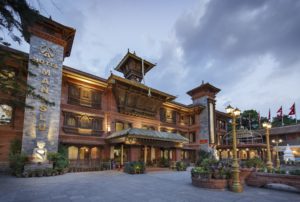
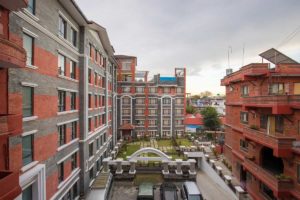
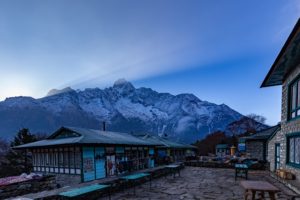
How many hours do we trek each day?
We will trek for six hours on average, but depending on the region you trek in, you might go for nine hours straight, including breaks for meals.
What transportation will it be to the trekking starting point?
Depending on the trekking region, either private transportation or air travel will be used.
Can I leave the things behind before heading for trekking?
Yes, we’ll tag your bag and keep it at your accommodation until you get back. Likewise, you should travel as lightly as possible when trekking.
Is it very cold in Kathmandu on my arrival?
There are four seasons and 300 days of sunshine in Nepal. As a result, Kathmandu’s lowest recorded temperature is -3 degrees Celsius, or 26.6 degrees Fahrenheit. However, while trekking, the temperature may drop to -13 degrees Fahrenheit or -25 degrees Celsius. For more details on what to pack and bring please contact your dedicated travel consultant or you can also contact us via E-mail.
Do I need to be extra careful of altitude sickness?
Our itineraries are made to give you plenty of time for acclimatization, reducing the likelihood that you will have altitude sickness. Every evening before or after dinner, our extremely knowledgeable guide will give us a briefing for the following day’s trekking, including instructions to prevent altitude sickness over 3500 meters. You must notify our guide right away if you have shortness of breath, headache, exhaustion, nausea, vomiting, a rapid heartbeat, or insomnia since altitude sickness can be fatal.
How many kg of bag pack am I allowed to carry?
The greatest option is usually to trek light. The best-recommended backpack weight is 10 kg for trekking bags and 5 kg for carry-on luggage because one must also include basics. (It also serves as the flight to Lukla’s weight restriction.)
Will there be a porter to carry my bag pack apart from the guide?
Yes, a porter will assist you in carrying the trekking backpack packs.
Can you tell me about the food in the mountains?
Most of the food is freshly prepared, but meats may have been stored for a while. Freshly prepared Daal and Bhat, a staple of traditional Nepali cuisine, are the finest.
How basic are tea houses, can I shower every day?
A basic bed, private or shared bathrooms, cold water in the absence of electricity or sunlight, charging the wifi battery, and the absence of a room heater. This is how simple tea houses seem. Further, during the cold winter, the water freezes in the pipe leaving no running water.As mentioned earlier, having a hot shower (or bucket full of hot water) is feasible in most tea houses, however, if unfavorable circumstances like an electricity cut-off occur, you may have to wait to take a hot shower.
Is there wifi or cellular signals in the mountains?
In the tea houses along the trails, there is wifi, however, the signal strength and speed may not be as advertised. On request, Team Elite Explorer will provide you with a local sim card for data subscription.
How about power, will there be charging points?
There will, in fact, be charging ports. Be considerate when charging your electronics as tea houses provide shelter for other hikers as well.
In case of medical issues, how will I get assistance?
Our guide will evaluate the case according to its seriousness, seek advice from the office as necessary, and then decide on the spot whether to transport the patient to the nearest medical facilities or call for help. When trekking in Nepal, kindly make sure to have comprehensive travel medical insurance.
Can 3 years and 80 plus age trek in the mountains?
Every age group can find the ideal trekking trails in Nepal. So every one of any age can hike in the mountains. When working with infants and the elderly, we take extra precautions both in the planning of the itineraries and on the ground.
Lastly, how fit should I be for trekking?
For the trek, you need to be both physically and mentally prepared. The outcome of your adventure entirely rests on you. We advise selecting the trekking routes based on your degree of fitness. There is little doubt that shorter routes are simpler than longer ones. A higher level of fitness will be needed for the longer treks. So, try to be in top physical shape.
.


